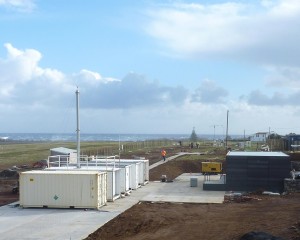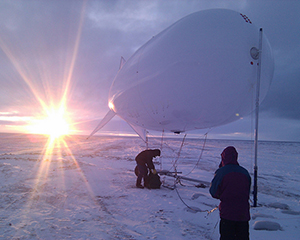At the 2014 European Geophysical Union’s (EGU) General Assembly in Vienna, Austria, researchers will hear how data from the Atmospheric Radiation Measurement (ARM) Climate Research Facility is contributing to advances in climate models. Through its fixed, mobile, and aerial observatories, ARM provides the global science community with free data about clouds, aerosols, precipitation, and radiative energy. Highlights for the EGU community this year include:

Back to the Azores
Based on the successful mobile facility deployment in support of the Clouds, Aerosol and Precipitation in the Marine Boundary Layer (CAP-MBL), the Azores were identified as having ideal conditions to warrant a fixed site. In September 2013, the ARM Facility resumed obtaining continuous measurements on Graciosa Island, Azores, with its newest fixed site. This site will focus on the life cycle and characterization of marine stratocumulus clouds and ocean atmosphere interactions, which play a critical role in boundary layer dynamics and in the validation and testing of cloud parameterizations for the large-scale computer models and improved climate predictions. Kim Nitschke, Los Alamos National Laboratory, will share the capabilities of the Azores ARM Facility and encourage discussions for its collaborative uses in two poster sessions.
- EGU2014-6077. Eastern North Atlantic (ENA) Graciosa Island – ARM Facility. K. Nitschke, E. Azevedo, P. Ortega, and A. Haruta, Monday, April 28, 5:30 pm, Red Posters.
- EGU2014-6962. Cloud-Aerosol-Precipitation Interactions Research Platform – Eastern North Atlantic (ENA) Graciosa Island ARM Facility. K. Nitschke, E. Azevedo, P. Ortega, and A. Haruta, Tuesday, April 29, 2:30 pm, Yellow Posters.
Biomass Burning in the U.S.
During the summer and early fall of 2013, the ARM Facility sponsored the Biomass Burning Observation Project, an aircraft-based field campaign, to study in situ the evolution of particulate emissions from biomass burning. Results from wildfires sampled in the Pacific Northwest and controlled agriculture burns in the south-central Mississippi valley will be presented by the campaign principal investigator Art Sedlacek from Brookhaven National Laboratory.
- EGU2014-9226. Evolution of Biomass Burning Aerosols in the Near Field. A. Sedlacek, L. Kleinman, W. P. Arnott, K. Adachi, P. Buseck, E. Lewis, T. Onasch, M. Pikridas, J. Shilling, S. Springston, J. Wang, and R. Yokelson, Wednesday, April 30, 4:30 pm, Room G5.

Reaching New Heights in the Arctic
Featured in a poster presented by Mark Ivey, Sandia National Laboratories, a new ARM capability is shared for operations of unmanned aerial systems to support science missions over Oliktok Point, Alaska. Recently, approval has been obtained to launch tethered instrumented balloons to make measurements of clouds in the boundary layer, including mixed-phase clouds. Also highlighted on the poster are the major upgrades, like scanning radars, to facilities in Barrow, Alaska, and the deployment of a mobile facility at Oliktok Point.
- EGU2014-2273. Unmanned Aerial Systems, Moored Balloons, and the U.S. Department of Energy ARM Facilities in Alaska. M. Ivey and J. Verlinde, Wednesday, April 30, 5:30 pm, Blue Posters.
Examining Storm Life Cycles
Among the sessions of interest to the ARM community, the evolution of convective storms will bring together the remote sensing community, cloud physicists, numerical modelers, and forecasters to advance current understanding of the convective storm life cycles. Co-Convener, and ARM radar scientist, Pavlos Kollias will represent the ARM perspective.
- EGU2014-14027. The Evolution of Convective Storms: Observation, Modeling and Validation Strategies. Conveners: T. Stein and S. Troemel Co-Conveners: M. Mittermaier, K. Wapler, P. Kollias, and S. Hagos. Thursday, May 1, 5:30 pm – 7:00 pm, Room B14/Yellow Posters.
Featured talks in the scientific program include:
- EGU2014-8033. The Differing Impact of Local and Remote Moisture Sources on Cloud Formation and the Surface Energy Budget at Summit, Greenland. A. Solomon, M. Shupe, and Ola Persson, Monday, April 28, 8:45 am, Room B16.
- EGU2014-1289. MJO Initiation: A Biennial Report of the CINDY/DYNAMO Field Campaign. CC. Zhang, K. Yoneyama, and C. Long, Tuesday, April 29, 8:45 am, Room B11.
- EGU2014-4420. Prospects for Modeling Global Cloud-Aerosol-Precipitation Interactions Involving Cumulus Clouds. S. Ghan, J. Fan, and M. Wang, Tuesday, April 29, 2:30 pm, Room B15.
- EGU2014-7715. Shallow to Deep Convection Transitions in Madden-Julian Oscillation and the Role of Detrain Moisture from ITCZ. S. Hagos, Thursday, May 1, 3:45 pm, Room B14.
See the presentations page for a list of talks and posters featuring data and research results from the ARM Facility and other DOE Office of Biological and Environmental Research projects.

